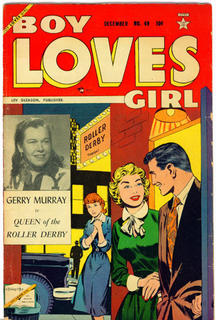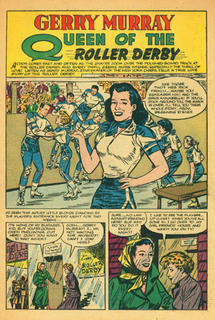
I'm not a "real" historian in the sense that I never studied history (other than those 4 required classes in college) and I don't really do research for a living (I write boring pharmaceutical documents, whose research is whatever thousand-page tables and graphs they plop down in front of me), but I am an observer of historical research, both inside and outside of the field of comics.
And in both arenas (the large banner of HISTORY and the very small piece of it
comics history), there seems to me to be a sense of constantly wanting to discover new things, often times at the expense of accuracy and common sense. And often times it gets to the point that the historical discoveries of someone or something becomes more important than what that someone did or something was. Who Shakespeare was, for example, seems much more important to some than what Shakespeare wrote. Abraham Lincoln being gay is a recent one (or at least recent to my ken), in that several new biographies' successes seem to hinge on proof that Lincoln locked up the wife in the West Wing of the White House not because she was nuts but because he enjoyed the company of men better.
And comics is no different, although sometimes I wonder if our scholarship is based less in the need for new discoveries and more on the need to increase the value of previously non-important comics.
About a decade ago, the Marvel prototype craze hit comicdom. No longer was it good enough to buy the first appearance of The Hulk, that giant, green-skinned thorn in General Ross's hide, but you also had his
first first appearance, when he was a hairy gray beast in an early issue of
Journey into Mystery. No matter that it really wasn't anything like the super-hero Hulk -- no green skin, no gamma radiation -- the mere fact that they shared the same name and company was good enough for people to yell "prototype" and suddenly a $20 comic was an $80 comic. (Tom Lammers did a terrific job of outlining what was and wasn't -- with even the was group being tenuous -- related to the later Marvel Silver Age heroes in several issues of
Alter Ego, beginning with #29.)
Now you're obviously thinking to yourself, "Not romance comics. There were no prototypes of them, were there?" And, to me, the answer is a clear no. To others, however...
Most people (and I'm assuming most who bother to read this blog, even though I haven't directly mentioned it) know that Joe Simon and Jack Kirby produced the first romance comic,
Young Romance, which was published in mid-1947 (a September-October cover date). They caught off guard the rest of the comic publishing world so much, they didn't have a competitor (other than their own
Young Love) for nearly 2 years, even though it was selling exceptionally well. So you'd think that this would be a slam dunk, then. Cut and dried,
Young Romance #1 was the first romance comic.
Well, not entirely, at least for some.
Romantic Picture Novelettes showed up on newsstands in 1946 (I'm not sure when, exactly, as it has no specific date on its cover or indicia). Well that sounds like a romance comic, I'm sure you're all saying to yourselves. The cover showed a couple, sitting lakeside, with the fellow leaning in to grab a smooch from his pretty date. And the word "Romantic" is in the title, for crying out loud. But if you look more closely (by that I mean, look on the inside -- and on the blurb in the lower right-hand side of the cover) you'll see that it says "A Complete Mary Worth Adventure".
As some of you may know
Mary Worth was (and is) a comic strip, starring a busy-body old woman (Mary Worth, naturally) who's always poking her nose in other people's business. Said business often included the love stuff. (
Mary Worth is still being published today, with art by comic veteran Joe Giella. Yes, after nearly 70 years in newspapers, that Mary is still alive and kicking.)
But newspaper reprints have never really been that important to the comic book other than helping start up the format.
Comics on Parade,
Famous Funnies, et al., were crucial to getting comics on the newsstands, but their content rarely was. The content (at least the most popular) in comic books was original (although quite derivative).
But that hasn't stopped the
Overstreet Comic Book Price Guide from having
Romantic Picture Novelettes as the first "Love Comic. To me, its claim to fame is that it's yet another comic strip reprint that failed on the newsstand. And that's not much of a claim.

Another Overstreet proclamation (and it seems that they are one of the worst in creating dubious comic history) is that
My Date was a romance comic.
My Date was a Simon and Kirby-produced comic released by Hillman (known mostly for their
Airboy title), which was a teen-humor title in the vein of Archie and
others of its ilk. It did, however, have a feature in it called "My Date -- Unusual Dates as told to Jean Anne Marten, 'My Date's' famous young people's counselor". The 6-page story (the only issue of the titles I own is #2, so that's all I can talk about with any confidence) featured art by Dan Barry, and while it was about a date and had romance and did end with a peck on the cheek, it was still funny.
Was this a romance story? Sure. Does that mean that
My Date was a romance comic? I don't think so. The rest of issue #2 features the cover feature starring Swifty Chase, another starring Violet, an awkward girl who doesn't know the right way to impress her beloved Merril, Ginny, a takeoff on Quality's Candy, and The Rosebud Sisters, "Those 70-Year-Old Teen-Agers".
The first issue of
My Date was cover-dated July 1947, a couple of months before the first
Young Romance, and while I think that Simon and Kirby certainly had the latter in mind when doing the former, I'm pretty confident in saying that it's not a romance comic. To put it in a super-hero perspective, it's what
Challengers of the Unknown is to the
Fantastic Four. There are similarities, but one is a sci-fi/adventure series, the other is a super-hero series.
I think it's important that we call things for what they are, and not for what they might be. And
Romantic Picture Novelettes and
My Date aren't romance comics.







